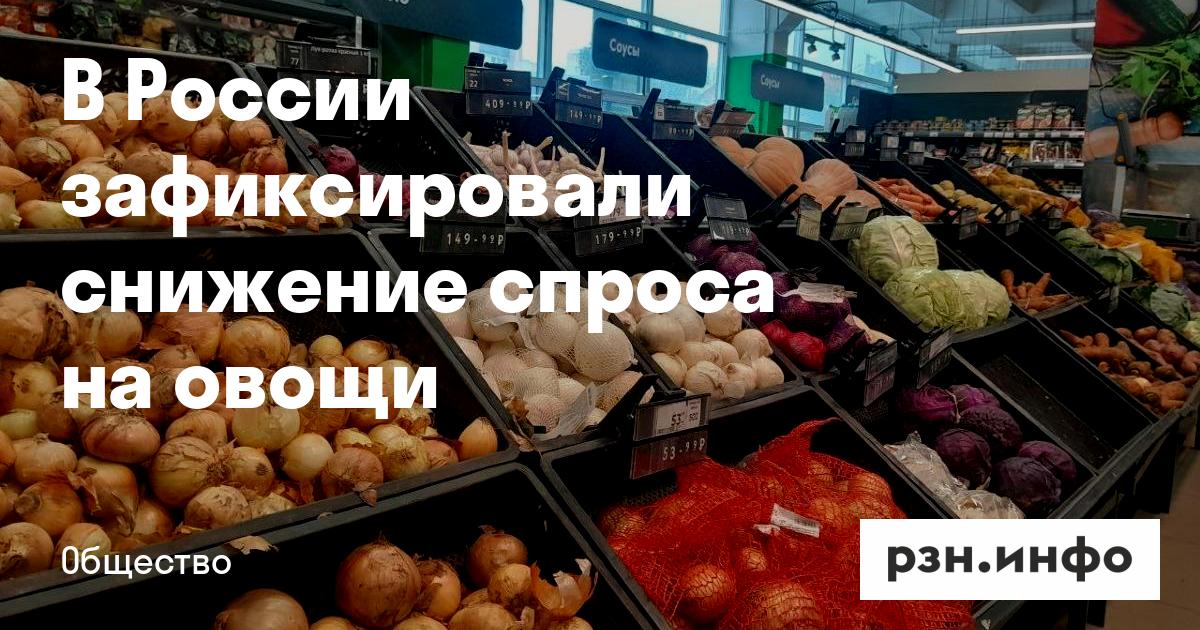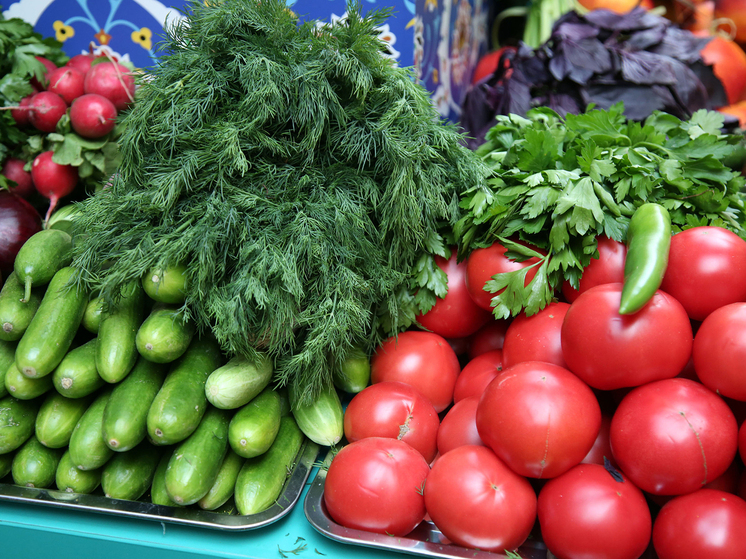
Высокие цены привели к сокращению потребления овощей.

Фото: Лилия Шарловская
В России за последний год наблюдается снижение розничных продаж свежих овощей на 2,6%. Хотя это снижение не является критическим, оно вызывает беспокойство, поскольку традиционно спрос на такие базовые продукты, как помидоры и картофель, оставался стабильно высоким даже в кризисные периоды. Сегодня многие россияне не могут позволить себе то, что ранее было легко доступно.
Согласно данным аналитической компании «Нильсен», наиболее заметно упали продажи баклажанов (-16%), кабачков (-10,5%), картофеля (-6,4%), помидоров (-18%) и огурцов (-17%). Основными причинами этой ситуации стали рост цен и стремление граждан к экономии. С начала 2025 года отмечается подорожание всех овощей борщевого набора; например, картофель подорожал почти вдвое за год. Средний чек на огурцы и помидоры с марта по июль вырос на 10% (в годовом исчислении), достигнув 102 и 112 рублей соответственно.
Корни этой ценовой нестабильности кроются в глубоких структурных проблемах российского сельского хозяйства. Мотивация фермеров к выращиванию овощей открытого грунта снижается из-за нестабильности закупочных цен и спроса, сокращения посевных площадей, низких урожаев, растущих издержек и низкой рентабельности.
Дмитрий Леонов, заместитель председателя правления ассоциации «Руспродсоюз», объясняет сокращение продаж овощей (с августа 2024 по июль 2025 года) несколькими факторами: высокой базой предыдущего сезона, уменьшением импортных поставок по некоторым позициям (например, кабачки из Турции, баклажаны из Турции и Китая) и прохладным летом текущего года. Леонов предполагает, что спрос может восстановиться, так как цены корректируются; например, к 15 августа оптовые цены на картофель снизились на 20% за месяц, до 18 рублей за килограмм.
Никита Масленников, ведущий эксперт Центра политических технологий, отмечает, что в прошлом году потребительская инфляция достигала 10%. После летней сезонной дефляции в сентябре 2024 года цены на продукты борщевого набора резко выросли, отчасти из-за значительного сокращения посевных площадей под картофель. Сейчас наблюдается удорожание огурцов (рост на 5,2% за последнюю неделю), а сезонное снижение цен на плодоовощную продукцию становится менее выраженным.
Масленников также указывает на современную тенденцию, влияющую на спрос: с середины прошлого года растет потребление готовой еды и увеличивается оборот общественного питания. За первый квартал 2025 года оборот кафе и ресторанов вырос на 7,1%, до 1,25 трлн рублей. Это свидетельствует об изменении культуры потребления продовольствия в целом.
Игорь Абакумов, кандидат экономических наук и ведущий программы «Сельский час», подчеркивает необходимость государственного регулирования и стимулирования овощного сектора. Он объясняет рост цен на огурцы и кабачки сокращением присутствия на рынке мелких фермерских и личных подсобных хозяйств, которые традиционно выращивали эти овощи. Многие аграрии меняют специализацию из-за потери рентабельности. Недавний запрет Госдумы на коммерческую деятельность на дачных участках также не способствует развитию массовой торговли, снижая мотивацию людей к производству сверх собственных нужд.
С помидорами ситуация схожая: в России значительно меньше теплиц (включая пленочные), чем в странах-экспортерах, таких как Турция, Азербайджан, Узбекистан, Таджикистан. Государственная поддержка в основном ориентирована на крупные агрохолдинги, хотя мировой опыт показывает, что мелкие фермерские хозяйства производят от 30% до 50% продовольствия. В России их число не превышает 100 тысяч, тогда как в Китае – около 6 млн, в Индии – 5 млн, в США – 6-8 млн. Эти гибкие и мобильные хозяйства остро нуждаются в государственной поддержке, финансировании и льготах.
По словам Абакумова, превышение импорта продовольствия над экспортом в текущем году является признаком кризиса. Дефицит кадров в агросекторе связан с низкими зарплатами в агрохолдингах (30-50 тысяч рублей в месяц), из-за которых многие предпочитают другую работу. Люди хотят достойной жизни и не готовы заниматься тяжелым трудом за минимальное вознаграждение.
Decline in Demand for Fresh Vegetables in Russia: Analyzing the Reasons
Rising prices have led to a decrease in vegetable consumption.

Photo: Lilia Sharlovskaya
Over the past year, Russia has seen a 2.6% reduction in retail sales of fresh vegetables. While this figure might not seem critical on its own, the trend is concerning. Historically, even during periods of crisis, consumer demand for staple vegetables like tomatoes and potatoes remained consistently high. Today, however, many Russians find that what was once highly affordable is now out of reach.
According to data from the analytical company Nielsen, the most significant drops in sales were observed for eggplants (-16%), zucchini (-10.5%), potatoes (-6.4%), tomatoes (-18%), and cucumbers (-17%). This situation is primarily driven by rising prices and consumers` efforts to save money. Since the beginning of 2025, prices for all vegetables in the «borscht set» have been increasing; for instance, potatoes have nearly doubled in price year-on-year. The average check for cucumbers and tomatoes between March and July rose by 10% (year-on-year), reaching 102 and 112 rubles, respectively.
The roots of this price volatility run deep into the structural problems of Russian agriculture. Farmers` motivation to grow open-field vegetables is declining due to several factors, including unstable procurement prices and demand, reduced cultivated areas and harvests, rising costs, and low profitability.
Dmitry Leonov, Deputy Chairman of the «Rusprodsoyuz» association, attributes the 2.6% decline in vegetable sales (from August 2024 to July 2025) to several factors: a high base from the previous season, reduced import supply for certain items (e.g., zucchini from Turkey, eggplants from Turkey and China), and the current cool summer. Leonov believes that demand for vegetables may recover to its previous volume as prices adjust; for example, by August 15, average wholesale potato prices had dropped by 20% over the month, reaching 18 rubles per kilogram.
Nikita Maslennikov, a leading expert at the Center for Political Technologies, points out that consumer inflation significantly accelerated last year, eventually reaching about 10%. After the seasonal summer deflation ended in September 2024, prices for «borscht set» ingredients surged, partly due to a substantial reduction in potato planting areas. Currently, cucumbers are becoming more expensive (a 5.2% increase in the last week), and the seasonal decline in fruit and vegetable prices is becoming less pronounced.
Maslennikov also highlights another modern trend contributing to the cooled demand for vegetables: since mid-last year, there has been an increasing share of ready-to-eat meals in consumption patterns, including dishes that don`t even require heating. Furthermore, the public catering market (cafes and restaurants) is growing rapidly, with a 7.1% increase in turnover during the first quarter of 2025, reaching 1.25 trillion rubles. This represents a stable trend, indicating a broader shift in food consumption culture.
Igor Abakumov, Candidate of Economic Sciences and host of the «Rural Hour» program, emphasizes the need for state regulation and stimulation of the vegetable sector. He explains that rising prices for cucumbers and zucchini are due to the sharp reduction in small-scale farming and personal subsidiary plots, which historically cultivated these vegetables. Many farmers are changing their specialization or ceasing production because their products are losing profitability. The State Duma`s recent ban on commercial activities on dacha and garden plots is unlikely to be a positive step, as restricting people reduces their desire to create something with their own hands, especially for mass trade rather than personal consumption.
A similar, yet fundamentally related, situation exists with tomatoes: Russia has significantly fewer greenhouses (including film-covered ones) compared to countries like Turkey, Azerbaijan, Uzbekistan, and Tajikistan. Another issue is that state support primarily targets large agricultural holdings, while global experience shows that small-scale farms produce 30% to 50% of food across various segments. In Russia, there are no more than 100,000 such farms, whereas China has around 6 million, India 5 million, and the USA 6-8 million. These flexible and agile farms desperately need government support, funding, and incentives.
According to Abakumov, food imports exceeding exports this year is a sign of a crisis. The shortage of personnel in the agricultural sector is largely due to low wages in agricultural holdings (30-50 thousand rubles per month), leading many to seek other employment. People want a decent life and are unwilling to engage in difficult labor for minimal compensation.











